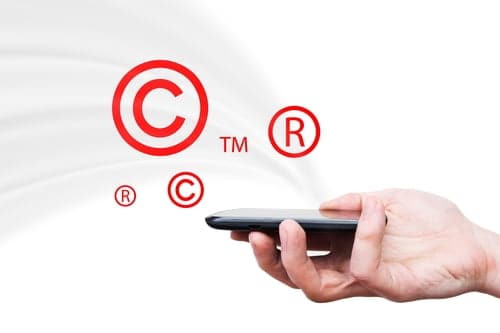A vast amount of US-owned’ intellectual property’ has been shamelessly plundered in some countries. US movies and music etc., are regularly pirated or bootlegged and can result in jail time for copyright infringement as a criminal activity like in a high-profile case of 23 October 2017.1 But that’s not the main problem facing most small business owners. It’s stuff like patented designs, photographs, illustrations, business systems, manufacturing processes, etc., being ripped off, which causes the worst economic pain for intellectual property owners such as copyright.
What is Intellectual Property?
Intellectual property is all rights to the sale or licensing of any new idea or thing at all, which has been put into material form, be it a book, a movie, a song, a plan, a design, a scientific technique, a business system, a recipe, a computer program or whatever. Copyright is the broadest form of intellectual property. Everything original you produce on paper, canvas, or computer, in a recording, or some other shape or form, is protected by copyright. The Designs Act also covers three-dimensional stuff 2003, if it is an outward appearance, or the Patents Act 1990, if it contains an underlying invention. Of course, there are cases where a product may have copyright, patent, and design protection all at once.
How to own the copyright
The Copyright Act 1968 regulates copyright in Australia. The Act calls a ‘work’ anything written, drawn, made, noted (like music or choreography), recorded, or computerised, which is original, i.e. not copied from someone else. There is no registration or certification process to go through – copyright automatically arises upon creating a ‘work’. The ‘author’ or maker of work is the owner of the copyright, which means that they, and nobody else, has the exclusive right:
- to reproduce it in material form and to publish, perform, communicate and adapt it, and
- to sell, broadcast, rent out or license its use.
The ‘publisher’ owns the copyright in the published edition of a work.
When the author decides to sell the work’s copyright, then the new owner gets all these same rights with it, usually via a Copyright Assignment Agreement. When the author decides to license the use or reproduction of the work, then the licensee has the right to trade in, or hire out, the work or its reproductions, subject to the terms of a Copyright Licence Agreement. Copyright lasts during the author’s lifetime and seventy years after their death. You may wish to write your children out of your Will right now!
Copyright overlap with Design Registration
Some artistic works covered by copyright may also be suitable for design registration under the Designs Act 2003, but that involves a formal application for registration plus certification before that right can be enforced against infringers.
What if somebody infringes my copyright?
A good example is clothing. It is quite common for designers to have their clothes copied, either in every detail or a ‘substantial part’ of it. What can designers do when that happens, and there is no design registration in place? Section 115 of the Copyright Act 1968 potentially applies, and they can:
- Go to court to get an emergency injunction to stop people from destroying, hiding, selling, or offloading evidence. We’ll look at those injunctions in a separate article.
- Go to court and ask for an injunction to order the people copying to stop selling any more of the rip-off clothes. You can also get ‘take-down orders’ for websites selling the copy stuff.
- Go to court and sue for damages. You can choose between legal damages for your losses or an ‘account of profits from the copyright infringer if you win.
Damages are based on harm to you and your business, both financial and reputational. So that could be how much the copier would have had to pay you for the licence, for instance.
An account of profits is a recovery of profits made by the people copying the clothes. Even if they can prove they didn’t know they were copying, you are still be entitled to an account of profits.
You don’t need to show an intention to infringe – where the article is a ‘direct’ infringement of yours, i.e. a reproduction that is sufficiently similar or using a ‘substantial part’ qualitatively, other than by independent creation of new work.
Flagrant breaches of copyright
It sounds fun, but not if it’s being done to you! If the breach of copyright is particularly bad, done knowingly, or done deceitfully, under s115 of the Copyright Act, the courts can award ‘additional damages’. If you think your case is a flagrant breach, you should ask only for damages, not an account of profits, because additional damages are not awarded with accounts of profits.
To give you the flavour of flagrant breach cases, here are a couple of examples:
- A music festival promoter defrauded the copyright owner of certain music by dishonest statements and actions. The damages reflecting lost licence fees was about $40,000, but the court-ordered ten times that amount in additional damages!
- Seafolly, a swimwear maker, brought an action against another swimwear maker over floral fabric designs being used, which Seafolly said it had copyright over. The court agreed and gave Seafolly about $80,000 in damages for lost sales, about $20,000 for reputational damage, and a whopping $150,000 in additional damages because the copier company was deceitful and dishonest, continued breaching copyright during proceedings, and its officers were dishonest and evasive in the witness box.
Urgent court remedies may be available in your case, such as an Anton Piller search order discussed in our earlier article on that topic. Or a Mareva Injunction may be appropriate, in the circumstances discussed in our article on that).
If you have any matters regarding copyright or infringements of copyright, please contact us for an initial free no-obligation discussion.
Case reference:
1. William de Lorenzo v Director of Public Prosecutions (Cth) [2017] VSCA 270 23 October 2017


